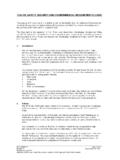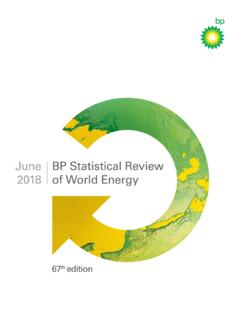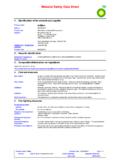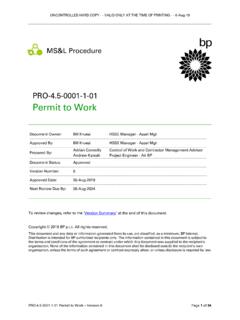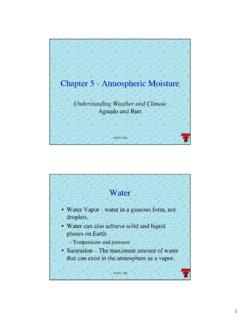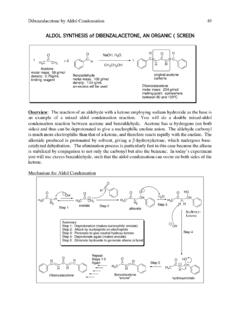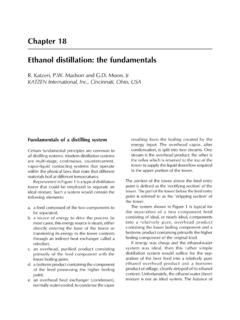Transcription of A guide to storing fuel - BP
1 Fact SheetFor further information: Please call the BP Lubricants and Fuel Technical Helpline on 1300 139 700. A guide to storing fuel At BP our fuels are manufactured to rigorous quality guidelines. In addition, the fuel in the underground tanks at our petrol stations is replenished so regularly that storage problems rarely occur. However, in smaller storage containers such as drums, storage problems may occur. This fact sheet contains useful information to help you maintain the quality of fuels away from the petrol station. For domestic use, fuel should be stored in steel cans of litres, litres or in litre jerry cans. Plastic containers of the approved type with the Australian Standards mark (AS2906-1991) on the bottom can also be used.
2 Please note that the storage of fuel in any quantity is hazardous and this fact sheet does not include safety and legislative guidelines for fuel storage. For details on these safety and legislative guidelines for fuel storage please refer to the Australian Standard AS1940. PetrolPetrol is a mixture of many components with different properties that contribute to the performance of the fuel. When petrol is kept in an open container where it is exposed to the air, it will - in time - completely evaporate. As it evaporates, the composition and properties will change because different components evaporate at different rates. This is a normal feature of petrol and helps describe the process which takes place when it is stored in equipment fuel tanks.
3 Petrol in sealed containers The storage life of petrol is one year when stored under shelter in a sealed container. Once a seal is broken the fuel has a storage life of six months at 20 C or three months at 30 in equipment tanksThe storage life of petrol in equipment fuel tanks is one month. This can be extended by topping up with one third of fresh fuel, which restores the volatile components that have up with fresh fuel will help, however it is not a foolproof strategy for engines that are used only intermittently. The following principles may also help:> Keep the tank half full to stop water vapour from being sucked in and condensing.
4 > Consider using a fuel that contains anti-oxidants, metal deactivators and corrosion inhibitors to protect metal surfaces; such as BP Ultimate.> Use a hotter spark plug to help to reduce carbon of how petrol changes when stored in a fuel tankPrOPErTyWEEK 1 WEEK 2 WEEK 3 WEEK 4 WEEK 5% volume lost3581015 Octane kg/l 15 air fuel ratio at constant volume13 :1At the end of five weeks the fuel is 5% heavier and the fuel air mix will contain more fuel. This means your engine will run richer possibly resulting in fouled spark plugs and higher fuel in boatsPetrol in boat engines exposes the fuel to conditions that are not normally encountered in cars, including lengthy storage and term storageWhen preparing to store a boat for extended periods two months or more, it is best to completely remove all fuel from the tank.
5 If it is difficult or not possible to remove the fuel, maintaining a full tank of fuel and including a fuel stabiliser to provide fuel stability and corrosion protection is recommended. A partially full tank is not recommended because the void space above the fuel allows air movement that can bring in water through condensation as the temperature cycles up and down. This condensation can potentially create operational and two stroke enginesWhen two stroke fuel is mixed correctly it has the same storage requirements as petrol. Problems arise when excessive two stroke oil is added. Under this condition the oil may separate from the table below is useful for mixing two stroke volumes and determining oil quantities.
6 It shows the amount of oil in ml required for litre, litres and litres of fuel. Always refer to the owner s manual for correct fuel to oil ratio for your to Oil litre of litres of litres of litres of mix16 to167mL335mL670mL1350mL20 to 153mL265mL525mL1050mL25 to 142mL210mL415mL835mL30 to 135mL170mL345mL690mL35 to 130mL145mL295mL590mL40 to 125mL130mL255mL510mL50 to 120mL100mL205mL410mL80 to1 13mL65mL125mL255mL100 to 110mL50mL100mL200mLDieselDiesel is not a volatile fuel therefore it does not suffer from starting issues or from issues of evaporation that petrol does. The main issue with diesel fuel in storage is the formation of gums and sediments that can block filters.
7 This is associated with darkening in the colour of the fuel. When stored under cover in sealed containers it will usually last for one year but it can last longer. The main problem with diesel fuel in opened containers is that moisture from condensation will create a favorable environment for fungus and bacteria that degrade the fuel. The simple solution is regular treatment with a biocide every six months when storing for lengthy storageLPG is not affected by the shelf life issues associated with petrols and diesels. It is stable when stored in sealed blendsregular unleaded with up to 10% ethanol has an equivalent storage life to regular petrol.
8 As with regular petrol, when using an engine after a period of storage, always top up with a third of fresh fuel first. With ethanol blends, this will remove trace water and dry the system out as well as freshening up the old is phase separation and how do I deal with it? (Ethanol fuel only)Phase separation is when water contaminates the fuel tank or fuel system causing the ethanol content to separate from the regular level at which phase separation can occur is determined by a number of variables, including the amount of ethanol, the composition of the fuel, the temperature of the environment and the presence of contaminants.
9 It is very important that the system is inspected for significant quantities of water in the tank before using gasoline with ethanol and to limit exposure of the fuel tank to excess water. If phase separation has occurred, it is necessary to completely remove all free water from the system and replace the fuel before continuing operation. Otherwise, engine problems could occur. For further information:Please call the BP Lubricants and Fuel Technical Helpline on 1300 139 1: Sample of fuel from fuel tank in which phase separation has occurred. The lower level is a mixture of ethanol and upper phase is petrol with a reduced level of ethanol.
10


